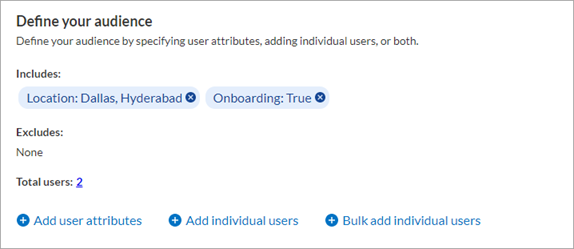You can edit an audience's name, owners, and users. Prior to modifying users, see Important information about audience modification and assignments below.
To edit an audience
- From the Admin menu, select USERS > Audience Management.
- Locate the audience you wish to edit .
- In the ACTIONS column,select
 >
>  Edit. The Edit Audience page displays.
Edit. The Edit Audience page displays. - Modify the audience name.
- Optionally, select the audience owners.
- Audience owners must have a user role of Learning Admin or Manager. Not all audiences need owners. Audience owners may receive an email notification when they are added or removed.
- Modify your audience definition. To assist you in your modifications, you see the current user attributes and users included and excluded from the audience. You also see the total number of users in the audience. You can add or remove either user attributes or individual users. Percipio recalculates the total number of users in your audience based on your new selections.

 To add user attributes
To add user attributesAny user attributes you add to your existing selection act as an AND. Users need to meet all attribute conditions to be included in the audience. User attributes do not apply to individual users added to the audience.
- Select Add user attributes.
- Select the user attributes and values for the audience.
You have the option to select either Equals or Does not equal when choosing to include or exclude users. Sometimes it may be easier to exclude one or two values, than to include 35.
- Optionally, select Add user attribute rule if you need to further refine your audience with additional attributes. If you specify more than one attribute, the user must meet all conditions to be included in the audience.
- Repeat for additional user attributes and values.
- When you are done adding all attributes, select Done.
The following rules apply when composing an audience based on user attributes:
- If you have only one rule where the condition is Equals, at least one of the user values has to match one of the rule values for the user to be included in the audience. Said another way, if the user does not have any values that match the Equals value, they are not included in the audience.
- If you have only one rule where the condition is Does not equal, the user must have any values other than the values defined in the rule to be included in the audience. Said another way, if the user has at least one value that matches the Does not equal value, they are not included in the audience.
- If you have more than one rule defined, the user must meet the condition of both individual rules to be included in the audience.
 To add individual users.
To add individual users.- Select Add individual users.
- Enter a user name, user email, first name, or last name in the search field. All active users containing the search term(s) display. You cannot add inactive users to new audiences.
- Locate the user in the list.
- Select
 .
. - Repeat for additional users.
- Select Add to audience.
 To remove attributes or users
To remove attributes or users- Select
 next to the users and/or user attribute rules you wish to remove from the audience definition. If there are more users than what displays:
next to the users and/or user attribute rules you wish to remove from the audience definition. If there are more users than what displays:- Select Add individual users.
- Select the Selected users tab.
- Select
 the checkmark to unselect all users that should no longer be in the audience. The user is immediately removed from the list.
the checkmark to unselect all users that should no longer be in the audience. The user is immediately removed from the list. - Select Add to audience to save your changes.
- Select
- Select Update Audience.
Important information about audience modification and assignments
If you change the name of an audience, and that audience has assignments made to it, all users that have not started the assignment will get an assignment email notification with a revised due date.
Scheduled assignments have a Start Date in the future. When you add a user to an audience with a Scheduled assignment, the assignment displays on the user's Assignment page on the Start Date.
In Progress assignments have a Start Date in the past. When you add a user to an audience after the Start Date, the user receives an email notification and the assignment displays on their Assignment page.
The time to complete the assignment depends on how you configured the assignment. If you configured the assignment with a fixed date, the user sees the fixed date, which could be past due. If you configured the assignment with number of days, the user has the same number of days as all other users to complete the assignment.
An assignment has the Number of days to complete set to 30 and a Start Date of September 1.
Jane Doe was part of the original audience, so the assignment started for her on September 1st. Jane's due date is September 30th.
John Doe was added to the audience on September 4th, four days after the assignment's Start Date. John's due date is four days later, on November 4th.